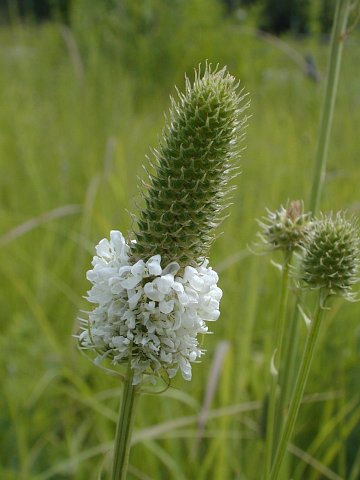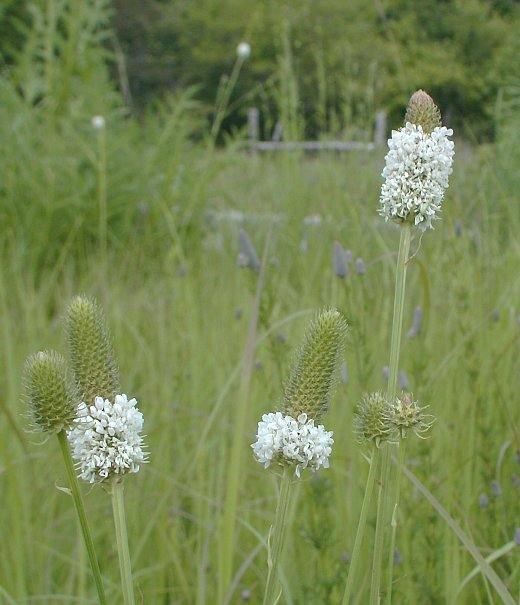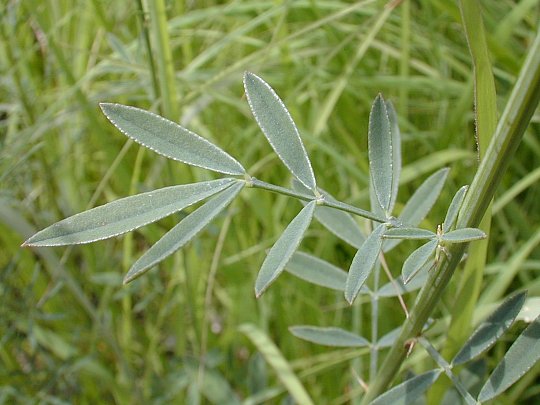Description: This perennial plant is unbranched or sparsely branched in the upper half, and 1-2½' tall. The pale green central stem has light longitudinal lines. The alternate compound leaves are oddly pinnate and about 2-7" long, consisting of 3-9 pale green leaflets. Each leaflet is linear or narrowly oblanceolate, about 1" long and less than ¼" across. The margins are smooth, and the underside of each leaflet has numerous translucent dots. Both the stems and leaves are hairless. There is a short cylindrical spike of white flowers at the terminus of the central stem and each of the major side stems. This spike is about 1-3" tall and ¾" across. The small flowers form a wreath around the bottom of the spike, which moves upward as the season progresses. Each flower is about ¼" across, with 5 petals and 5 white stamens. The flowers often have a pleasant fragrance.

The blooming occurs during early to
mid-summer and lasts about a month. The seeds fall a short distance
from the mother plant when the wind shakes the cylindrical spikes. The
root system consists of a central taproot that can extend 5' into the
ground.
Cultivation:
The
preference is full sun and mesic to dry conditions. The soil can
contain significant amounts of loam, clay, sand, or gravel. This plant
is slow to develop, but otherwise easy. Foliar disease isn't
troublesome. Drought resistance is very good.
Range & Habitat:
The native White Prairie Clover occurs occasionally in scattered
counties of
Illinois, but it is rare or absent in the SE section of the state (see Distribution
Map). Habitats include mesic to dry black soil prairies, sand
prairies, savannas, openings in upland forests, and limestone glades.
It is rarely observed in highly disturbed areas. Recovery from
occasional wildfires is good.

Faunal Associations: The nectar and pollen of the flowers attract bumblebees, Halictid bees (including green metallic bees), plasterer bees (Colletes spp.), Sphecid wasps, Tiphiid wasps, Syrphid flies, thick-headed flies (Conopidae), and small butterflies. Two oligolectic plasterer bees, Colletes robertsonii and Colletes wilmattae, visit the flowers of White Prairie Clover (Robertson, 1929; Krombein et al., 1979). Other insects feed on the seeds, foliage, and other parts of this plant. They include such species as the larvae of two butterflies, Colias cesonia (Dogface Sulphur) and Hemiargus isola (Reakirt's Blue), the seed-eating larvae of two weevils, Apion amaurum and Apion capitone, and Melanoplus keeleri luridus (Keeler's Grasshopper); see Opler & Krizek (1984), Sauer (2005), and Campbell et al. (1974). This plant is palatable and high in protein, therefore it is readily consumed by mammalian herbivores of all kinds, including rabbits, groundhogs, deer, and livestock. This can cause difficulties in establishing this plant in some areas. It is possible that small rodents may carry the seeds to their dens. Because of their high mortality rate, some of the seeds will remain uneaten, and thus are dispersed by these rodents.

Photographic
Location:
Photographs were taken at the Lincoln Book Bindery in Urbana, Illinois.
Comments:
White Prairie Clover often occurs in the same habitats as Dalea
purpurea (Purple Prairie Clover) – the two are often seen
together, although the former begins blooming about 2 weeks earlier
than the latter. However, White Prairie Clover is the less common of
the two plants. The most obvious difference between them is the
coloration of their flowers. In addition, White Prairie Clover tends to
have more elongated flowering spikes with hair-like bracts, and its
foliage is longer, sparser, with a lighter shade of green. Prior to
blooming, it blends into the background of grasses and other forbs
rather well, and is easy to overlook.